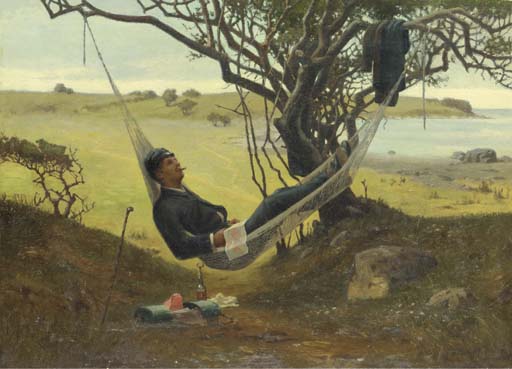The Pause That Refreshes
“The pause that refreshes” was a slogan coined in 1929 by Coca-Cola marketers, and nearly a century later it remains one of the most memorable advertising slogans for Coke, or for any other product. It was also in the 1920s that Henry Ford instituted a new policy at his automobile manufacturing plant to shorten workers’ shifts to eight hours and their work week to 40 hours, a model that soon became the standard throughout American industry. In 1938, the federal government established with the Fair Labor Standards Act a minimum wage and rules for most workers to receive time and a half payment for hours worked over 40 in a week.

An Afternoon’s Rest, an 1885 painting by Niels Frederik Schiøttz-Jensen (1855-1941).
A discussion of ways of coping in life from the 1964 film of The Night of the Iguana, based on the play by Tennessee Williams, directed by John Huston, and starring Ava Gardner, Deborah Kerr, and Richard Burton as the defrocked Reverend Dr. T. Lawrence Shannon.
None of that changes the need of people concentrating on their work to take a break from it every once in a while throughout the day, and for weeks or more at a time throughout the year. Robots have no need of breaks, but for the time being there are still jobs robots cannot do and those jobs will require the talents of fallible, sometimes frail humans. Enlightened management can choose to view breaks for workers as beneficial to both parties, since a more rested worker can be more productive in the long run than one who is run ragged. Less enlightened management may consider the burnout of workers as the cost of doing business, believing they are easily replaceable cogs in management’s profit making machine. That mindset prevailed over a hundred years ago, before Henry Ford, who was by no means enlightened in all areas, nonetheless saw that his workers and people like them were the buyers of his automobiles, and raised their wages and improved their conditions in the interest of maintaining a kind of partnership with them, rather than treating them wholly as chattel, as cogs in the gears of production.
— Vita 
